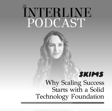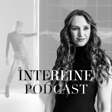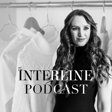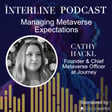Become a Creator today!Start creating today - Share your story with the world!
Start for free
00:00:00
00:00:01

The Tech And The Economics Behind The Rental Business
This episode - recorded live - features three members of the senior team behind data-driven clothing rental business Armoire.
Talking to Laura Butler, CTO, Sanober Mukadam, Chief Operating & Merchandising Officer, and Shefali McDermott, Head of Operations, Ben explores the infrastructure, the economics, and the technology that keep a complex business model running.
Transcript
Introduction to Armoire and Guests
00:00:10
Speaker
Hey, welcome to the latest episode of the Interline podcast. And today I'm joined by three people from Armoire. I'm joined by Laura Butler, who is the chief technology officer. I'm joined by Sonoba Makan, who is the chief operating and merchandising officer. And finally, by Shefali McDermott, who is head of operations at Armoire. And I think it's probably a good place to start to get into what Armoire is and how it works. So let's start by introducing the business.
00:00:39
Speaker
Anybody can take a run at this, so feel free to pick it up from your side, folks. How would you describe Armoire's business model, and how would you describe its target demographic? Who is Armoire for, and what is it about? And if you can also capture a little bit about the journey the company's been on recently, that would be great.
Armoire's Mission and Women's Empowerment
00:00:58
Speaker
OK, well, I'm the baby. I'm the newest member. So I'll kick it off, and then Shafali and Sinover, please, make this better.
00:01:06
Speaker
Well, we have to talk about our CEO, who is a force of nature, Ambika Singh. And she created our moire to help women reclaim time. She was a busy consultant, a woman going places and just didn't have time to deal with finding clothes, deciding what to wear, laundering, and all of that. And there's a ton of demands on the time and attention of women in modern society. And we also want to show up strong, look great, feel good. That takes a lot of effort.
00:01:36
Speaker
And we have multiple roles to play, right? We have career, we have family, we have community. And we think of clothing as our armor, right? It's not just fashionista stuff. Armoire, the name was chosen very deliberately. So that's kind of my take on it. I actually think we're selling confidence to women, but that's a side topic. Shafali, you've been with Armoire since the beginning. What would you say?
00:02:00
Speaker
Yeah, I mean, you know, Armar, we're definitely geared towards the woman who is looking for a service to help them get dressed in the most efficient way possible and just to make them look good and feel confident. I think, you know, yeah, we're selling confidence and compliments, and I think those go a long way.
00:02:27
Speaker
Perfect. So is there anything you wanted to add to that when you were kind of nodding in the background there? Yeah, I think they did a great job capturing that. They are, you know, women come to us because they are wanting to get out of tasks like laundry. They don't have the time to do that. They want to outsource that and we provide that service in a way. So
00:02:49
Speaker
Okay, perfect. And could each of you, I might as well come to you as a number, because we're just, we're talking there. Could you give me a short overview of your own sort of history inside and outside fashion?
Sonoba's Journey and Armoire's Growth
00:02:59
Speaker
And tell me a bit about what your day-to-day at Armoire looks like right now.
00:03:03
Speaker
Sure. History with fashion, very little. I was at Amazon for a little bit where I ran the outdoor apparel and sporting business. And so I guess you can say technical but stylish garments for a lot of the outdoor activities. And so I guess that's my little foray into fashion.
00:03:28
Speaker
In general, I think my experience, my background has been this intersection of operations, strategy, and product. In terms of where I started, I started in consulting, did a lot of product innovation as well as strategy work, and then moved to Groupon when I was a three-year-old company.
00:03:53
Speaker
From there, Amazon was sort of where I landed, where I was running multiple retail categories, as well as their product planning for Amazon logistics business. And so I guess for all of that, I landed at Armoure. And here I head up a lot of the merchandising work. And so the day-to-day at Armoure, we're in growth mode in the focus of scale.
00:04:19
Speaker
We are trying to create repeatable processes so that we can approach this growing business. In terms of how we are doing that, we're trying to use our data. We have a lot of data, and so we're trying to make better buying decisions early so that we can cater to this ever-growing customer base. I like to think of in fashion, and we've all experienced this.
00:04:49
Speaker
The most challenging sort of variable is understanding the customer demand and planning for that. Historically, and even now, like the long lead times is what sort of bogs down the industry in my opinion. And so for us, it's really about understanding the customer demand and listening to our customers. We want them to tell us what they want and we want to be agile enough to react to those needs
00:05:17
Speaker
in season when sourcing our inventory to meet those needs. Okay, perfect.
Laura's Tech Background and Armoire's Dynamics
00:05:24
Speaker
Laura, same question to you. I know your experience is firmly on the tech side. You mentioned you're the baby of the company. Tell me a bit about where you came from and what you're working on right now. And to be clear, I'm the baby of the leadership in terms of tenure, but I think I'm like the grandmother when it comes to age. I've been at Armoire for months, not quite. Yeah, four months and four and a half.
00:05:47
Speaker
It's been crazy. I think you'd asked earlier about what journey we've been on. We've literally been trying to keep up. Shafali can talk more about that, just constraints of physical space. My background, I have a hate history with fashion. I'm a nerd. I'm a Star Trek or Trekkie type person. I'm going to do this in European terms. I'm 1.524 meters tall and seven stone.
00:06:12
Speaker
Okay, so the fashion industry does not really make stuff for me, although I will say one of the beauties of working at Armoire is I get to, instead of my normal Pacific Northwest athleisure, you know, my dress fleece get to put on lovely garments like this Nora Gardner blue dress that Sinobre and team bought. My background is like, I'm kind of a professional misfit. I dropped out of Harvard to join Microsoft as a programmer.
00:06:42
Speaker
Most of the things I worked on were actually where hardware meets software. So Windows, Windows Phone. If you ever used a Lumia 1020 or 1520, that was me and my team. I knew some people who had Windows Phone. No, and they were supposed for the devices you could actually be proud of. It was a heartbreak story of another time. I didn't know that that would be relevant to our more. But if you think about, hey, where technology meets physical things, there's actually some parallels.
00:07:10
Speaker
My day-to-day, for a scale up, I wish there was a routine day-to-day. It's pretty much scrambling around support, letting down Shafali and Sonover at a rate they can hopefully tolerate, making sure bottlenecks get handled so there's quite a bit of reactivity when you're growing fast. Customers have questions and so on, and then trying to balance that with proactive work, both to make the tech team more efficient, but also to help
00:07:40
Speaker
Sonoba and Shafali scale. And then the other part of the customer base, of course, are the subscribers, right? Like just continually trying to improve like mobile. What do they want? What do they need? And how do we evolve it in place? And change is disruptive to everyone, right? Even if you make something better, someone had a habit and now you've moved their cheese.
00:08:02
Speaker
So sorting through all of that. So really just a bunch of like origami, space-time bending. No big deal. That's a good answer. It's hard to say that, right? Shafali has a tougher job. Sorry. No, no worries. We'll get to you in a sec, Shafali. And I think we're going to come back in a pretty big way to how tech is in service of both of those audiences. You just talked about the in-house and the downstream consumer as well. Shafali, I don't want to steal your
Economics and Merchandising at Armoire
00:08:25
Speaker
thunder. So tell us a bit about your journey inside and outside fashion and what your day-to-day looks like.
00:08:31
Speaker
Sure. I mean, I think maybe a constant theme here is I also have no fashion really history here. I came from originally working at PricewaterhouseCoopers in their tax department, trying to bring goods into the US appropriately. I then moved, I suppose, fashion to a textile company bringing goods to the US and Canada.
00:08:59
Speaker
And it ended up being very boring. And I was ready for a change. And I ended up switching careers completely and being an assistant to a CEO at a tech company over here in Seattle. I did that for about eight years. And along the way, befriended our CEO in Bika many, many years ago. And she came out of MIT with this crazy armoire idea and came home and was like, hey, you're my most
00:09:29
Speaker
Organized friend, how would you like to run the operations here? And I was like, let's do it. And so we started out of our friend's apartment in Capitol Hill in Seattle, and then grew out of that apartment, moved to a co-working space, grew out of the co-working space and moved into a lovely space where we're at today in Pioneer Square, where we're busting out of the seams.
00:09:55
Speaker
So, yeah, it's been a journey over the last almost seven years now, and it's been crazy to witness all the changes from the beginning. So, yeah. Okay. Well, no, that's awesome. Let's get into the weeds a little bit, then. So, there's a question, I think, for Sinubra and Laura, really. And I want to talk to you a little bit about the kind of walking the economic tightrope of making a business like this work.
00:10:25
Speaker
Because elsewhere in fashion, with a more traditional kind of model, you can get around some of the negative impacts of inaccurate planning by dealing in huge volumes and amortizing some of that stuff at scale.
00:10:43
Speaker
your model is a lot more of an encapsulation of why modern merchandising needs to become more of a data science and modelling exercise instead of something that starts with guesswork and then has all the rough edges averaged out and sanded off through scale. Is that a fair statement? Do you feel that way about merchandising? Yes, absolutely. I think
00:11:08
Speaker
In traditional fashion companies, you have tastemakers who are trying to predict trends at our more. Our merchandising team is not made of tastemakers. We don't necessarily try to predict what trends will take off six plus months from now. We spend a lot more time analyzing rental history, listening to our customers, getting their signal in terms of what is it that they like, what is it that they're looking for.
00:11:38
Speaker
What are their jobs that they need to get done? And how do they want to dress and feel? And so we understand those trends and then make decisions based on that. We have tools, and Laura will touch on that as well. We have tools that help us or give us that signal. We crowdsource from our customer base styles that they may like.
00:12:05
Speaker
styles they don't like, and we learn from that as well. We have review data. We look at that to understand fit, style, size preferences, and then we use that information to make additional predictions of what is it that we want to buy. Perfect. Thank you. Laura, anything you want to add there from the point of view of merchandising being as much of a data science as it is an art?
00:12:33
Speaker
Um, I have one thing and then I'd actually like to bounce past to Shefali because part of the economics of this business is the like inventory, like returns processing and shipping, right? Because we've got to get things to people. Um, on, yeah, I mean, supporting Sonover and Shefali is part of it. The one maybe unique thing.
00:12:55
Speaker
is because we're a rental business, right? We get to monetize our assets more than once, but also because we have the digital experience. We can surface things that we want people to get. Like let's say we have some items that people just aren't finding. We can sell them. We can put that in people's face. I mean, it has to be trustworthy, but we have some tools to help manage the inventory that we have through the digital product experience as well.
00:13:25
Speaker
when it really comes to the other part of the business and costs, economic tightrope. Shafali is the champ. Is it okay to hand to her? By all means, yeah, Shafali, your area of expertise. Go. Yeah. I mean, considering the rental space is
00:13:45
Speaker
a relatively new space in the last 10 years, there really aren't any off-the-shelf products. Somebody could just start this and start their own rental company. It's been a handshake between the ops team and the tech team to really work together to develop our
00:14:11
Speaker
soft tools that we use in the warehouse. We just have a customized internal tracking system to understand where our garments are at any given point. We utilize RFIDs in 100% of our garments, and that's been a huge change for us. 100% of our garments have RFIDs as of about a year and a half ago.
00:14:37
Speaker
And since then, we've been able to, once the product comes back to us, be able to move our inventory close to six times faster than we were before to be able to get those items back into inventory as soon as possible so that it's available for the member.
00:14:55
Speaker
And the RFIDs have really been a huge game changer for us and we haven't yet capitalized on 100% of I think the capacity that we have there. And we're still working on that. That's part of what I do on a daily basis is try to figure out how do we maximize the capacity that we have now that we have RFIDs in all of our governments.
00:15:23
Speaker
And how do we use that to our advantage?
00:15:26
Speaker
Okay, perfect. And I think we might kind of revisit the hardware side of things a little later on as well. But I think what's interesting from distinction between a rental business and a traditional kind of brand or retailer is that you're not selling the same idea of kind of the endless aisle, right? The original founding principle behind e-commerce is that you can offer a tremendous amount of variety and the issue is one of discoverability and curation rather than anything else.
00:15:55
Speaker
But you are still moving a lot of product. You've just established that the hardware is a key part of that. I think the thing to zero in on for me is that you're not just moving it the traditional way, like from you to the consumer. You're bringing it back in as well. You have reverse logistics with multiple stops along the way. What does it look like to manage that side of thing from an operations perspective?
Challenges of Reverse Logistics
00:16:18
Speaker
Because that's a very key distinction between the type of business that you have and a more traditional retailer.
00:16:25
Speaker
Right, exactly. So just about 100% of the packages that we ship out come back to us by design. And we want that stuff back so that we can get it back into circulation as quickly as possible for the next member so we can maximize the total inventory that we have at any given point.
00:16:47
Speaker
I guess, thankfully, since none of us come from a traditional retail background, I didn't know any different. And all of the packages that are coming back to us, so we're just processing them accordingly. And we do have a couple of very large cleaning partners in Seattle that we've partnered with to help us with the cleaning process. But essentially, the garments come back to us
00:17:14
Speaker
We give them to our cleaning partners and when it comes back from cleaning, it goes through a quality control process before it goes back again into our inventory. Part of our job is to make that turnaround time as quickly as possible while ensuring our garments are of quality to go back into inventory. It's not just stuff going out the door, it's also managing all the stuff coming back in the door.
00:17:44
Speaker
as part of the challenge there. Detachable belts are the bane of our entire existence. The dreaded belt rack, accessory rack, trying to ensure that all the pieces go back together at the end before going back into inventory is a challenge.
00:18:09
Speaker
I mean, yeah, do you tag individual kind of trims and components and pieces there? Or is it done at the garment level? That's something I hadn't even thought about. Yeah, everything is individual skewed. So, you know, it's a lot. We do tag every little detail about the garment so that it's easy for the operations
00:18:35
Speaker
team to identify the pieces, to make sure that when it comes back, it comes back with those pieces on so that the next customer has that understanding as well and knows that that piece is going to include those items. And so we want to maintain that flow. I just wanted to touch on the other aspect that was mentioned here in terms of that balance.
00:18:59
Speaker
The other handshake that happens is between the day-to-day operations team and merchandising in the same vein around this idea of how long is this item going to be in rotation. That's another data point that we really look at to understand the depth of how much to buy and the nuances around
00:19:27
Speaker
is this a staple item that may stay in rotation longer versus a statement piece or event-based item that might come back to us much faster. And so keeping those things in mind and using those data points and connecting it back to what the customers need is, again, impacts our ability to sort of make the prediction around buying.
00:19:54
Speaker
For sure. And I think it's a good time to talk about data points in general, because we hinted about, you know, we talked about merchandising and buying and the data modeling side of that. You're presumably capturing a lot of data points beyond that, you know, across kind of customer reviews, returns, trends and everything else. And
00:20:15
Speaker
Data is always kind of a problem and an opportunity, right? It's a problem in terms of managing its sheer scale and what you do with it. And it's an opportunity in terms of what it allows you to do to personalize customer experiences and things like that.
Data-Driven Personalization at Armoire
00:20:30
Speaker
Laura, I think this may be more of a question for you from the tech side, but feel free to jump in. Tell me a bit about how you're making use of all those data points, just really kind of surface insights for both Armoire's in-house team and for end users.
00:20:45
Speaker
Okay. So what's tough is the techie. Like I have no poker face, so I'm like a James Bond villain want to overshare. So I'll try not to give away any of our total secret sauce. Um, I will say that literally my first impression I had when I joined the company was I have never seen such sophisticated data infrastructure tooling. Um, we were like super cheap on things like on call software, you know, for when let's say there's a service issue, like we were on a cheap, we were on a free plan for that, but we have like incredibly fancy
00:21:16
Speaker
data tools like Looker and Segment and stuff like that, which already told me right away how important data was to the company. We have crazy amounts of data. We had to upgrade to a data warehouse. I don't think from just standard kind of database tables, a company, I don't know any other startup bar size that probably has that. So that's kind of scary. The flip side I would say is compared to the 2 billion Windows devices, and I ran the Windows 10 Insider program,
00:21:46
Speaker
It's still small. As always, I think trying to get meaning out of data is the hard part. I mean, one thing that might be interesting to your readers, we do have something we call positive signal, and I won't go into too much detail, but it's a pretty strong signal from our customers that they like an item and want to rent it. And that goes directly like on the red phone. Okay, I'm dating myself here. I told you I was not the baby in age to Cenobra and team. And then they have to be smart about
00:22:15
Speaker
wow, this thing's in demand. Should we buy more of it? But oh, wait, it's ugly holiday sweaters. And it's December 24th, right? I think that's tough. There's a lot more to be done. I think fragility of garments. There's some things that people would love absolutely to rent. It makes no sense for them to buy most people, unless you're like Rihanna or Beyonce or like Princess Kate, to go buy an incredibly gorgeous, bespoke, fragile gown.
00:22:45
Speaker
right? But those things don't wear very well. So I mean, there's a lot to be done there. You know, it really, it's really all around the customer experiences at the center of it. There's a lot of data we try to use on process improvements, like Shafali tracks, how long it takes, you know, to do quality control of a garment, how long it takes for something coming back to being back in inventory.
00:23:12
Speaker
and costs are a part of it, but it really gets back to the customer experience. Like, hey, if we get this thing back into inventory, someone else who loves it can get it, right? So, I mean, I think we're debugging data in the same way that we're debugging code, everybody is. And yet we always have tons of data and we never know the answer to a question easily usually. So then there's, okay, what are we trying to do with this data? What insights do we need?
00:23:42
Speaker
It's all very interesting to me because I spend a lot of time talking to brands who have a much more traditional model and one that is
00:23:52
Speaker
has an absence of data for the most part, you'll find that most fashion brands have the opposite problem to what you have. And that's, to me, I feel that there's somewhere in the middle where these two models can really start to benefit one another and share best practices and things like that, because you have a surfeit of information and your challenge is making sure that that's deployed in service at the right
00:24:15
Speaker
thing. If you're a more traditional brand, you're hurting for that. You're used to having a unidirectional channel to the consumer, and you're used to having just that one transactional opportunity, that one logistics model, that one merchandise plan, that one forecast. Yours has that
00:24:32
Speaker
circularity is perhaps the wrong word, but yours has that element of repetition to it. And it has that element of all of that reverse logistics. So to me, it's a very interesting data challenge. I'm sure it feels like insurmountable to you folks sometimes. But to me, it's fascinating because it's the opposite problem to what a lot the industry has. That's interesting to know. I mean, we're also very real time. I mean, we obsess over every single like in a real time, in real time feeds, like customer feedback, customer support questions and so on.
00:25:02
Speaker
because it makes all the difference in the world on keeping our subscribers with us and getting them the things that they want. Personalization is a tough one and maybe obviously AI is a big topic. We can get to that later. We're always trying to recommend things that we think will be good for the customer. There's seasonality, there's fit, there's their style. We're always tuning what we surface at the top level, but we also don't always know exactly what's in someone's head.
00:25:30
Speaker
So we don't want to be like over tastemakers either. So we're always using data on that front. I would say debugging personalization is really tough. You know, the more global you have of a thing, the easier it is to repro. You know, so like if you, Ben, were a customer of ours and you told us, hey, it's only showing me like black t-shirts.
00:25:51
Speaker
like, why? You know, we might have a little bit of a difficulty in, you know, figuring that out. No, I mean, that makes a lot of sense. And I think the other element to this, and I think this is probably the question for you, Sinobra, is that Armoure's different plans are, they're kind of pitched at different ideas. They're either kind of enhancing or replacing an existing wardrobe. And I guess that's a different prospect, because
00:26:15
Speaker
you're building assortments that have to cover a lot of potential bases, right? You're building things that have to cover, there's an amount of seasonality to it. There's the occasion aspect that we talked about before. There's brand diversity, there's everything else, but you're doing that at the same time as delivering that personalization that Laura's talking about, which is what people expect from a styling service. You're being proactive about saying, hey, this is something that we believe you want because we've seen that strong positive signal from before.
00:26:45
Speaker
How do you approach blending that kind of thing where you're saying we're trying to cover all these possible bases, but we're also trying to get to those granular kind of personalized recommendations? And how does some of the data in the systems we talked about support that? Yeah, it's I guess to start off, it's not perfect, but we definitely to view a lot of these data points. We have quarterly plans that we build out based on that and
00:27:15
Speaker
A lot of the way we think about it is from the variety and the number of items that we want to present to a customer as well as the diversity of choice. And so we have targets that we've established in terms of what that means for a customer that's coming on the site.
00:27:37
Speaker
You mentioned like the wardrobe enhancer versus I think like what we call it is like the lifestyle render. And I like to use myself as an example here. I was in a more customer for three years almost before I became an employee. And so I started out as like that wardrobe enhancer looking for stuff that's mostly for an event or maybe for some big work meeting.
00:28:03
Speaker
And, uh, slowly started, it started becoming more of like my lifestyle. And so the thing that, uh, what I started doing was picking items that were more staple core to like sort of my everyday need. And, uh, I think that that data insight is really valuable for us in terms of understanding.
00:28:22
Speaker
What are the types of products that these different types of customers are renting? And that feeds into sort of our targets of what type of variety and style choices do we wanna surface to our customers. And one of the things that we've started like really using as like our motto and our like
00:28:47
Speaker
religious belief is that we want to meet our customers for her like everyday calendar appointment needs. We want to be the wardrobe choice where she comes in and she's able to find whatever she's wanting to dress for. And so
00:29:04
Speaker
Keeping that in mind, we're thinking about the brands, we're thinking about the categories and the occasions that we want to carry product for. And in knowing that it's different from the traditional retailer model where a customer walks in and the retailer is really looking to sell that one item, what we're really trying to do is be that wardrobe for this customer. And so every time she comes in,
00:29:33
Speaker
Our goal is that we better have that assortment available in her closet. This is her everyday closet. And do we have product in stock?
00:29:44
Speaker
to meet those needs that we think she has. No, that's a great set of insights, I think, into the complexities of starting to merchandise on that basis. Shavali, we talked a bit about RFID before. We don't need to kind of, let's get that whole conversation, but I think you talked about some of the challenges there with the sort of item level tracking.
00:30:10
Speaker
I wonder if you wanted to look back to that and if there's anything in terms of the kind of opportunities that that unlocks as well, having that item level, that skewed level visibility, because again, for a lot of other brands, this is something that they're approaching from the perspective of traditional retail, right? They're approaching it from the perspective of what does my inventory look like? What does my channel allocation look like? How can I monitor a garment's kind of
00:30:37
Speaker
journey around the store and use it for dwell times and detract shrinkage and things like that. There's a whole different set of opportunities in the kind of bidirectional engagement that you folks have with your customers. Is there anything on the RFID side and the tracking side there that you think we haven't touched on that is more of an opportunity than a challenge? Well, I think
00:31:01
Speaker
The RFIDs, they're really most utilized in-house trying to get things from one end of the warehouse to the other in the most efficient way possible. But once they're out of the warehouse, it's kind of like we can now only have our data to rely on to understand when things are coming back to us. We have a good idea of how many packages people order on a monthly basis and how long
00:31:29
Speaker
people typically hold on to things before their intention of holding or returning it back to us. And so we have, you know, as far as like engagement with the customer, we have a good idea on, you know, maybe this customer has held on to something for so long that they might have the intention to actually buy the item. So we will take that opportunity to offer that as an option. And if not, it's also a reminder, hey,
00:31:59
Speaker
Remember, you can exchange your stuff. You don't have to hold on to it forever. Here's your opportunity to either buy the item or get a fresh wardrobe. So I think we're lucky that we've been kind of around this for so long that we have that incredible amount of data to understand when it's out of our hands, when we have an idea, when it's going to come back to us. And then once it's back to us, we have that tech tooling
00:32:29
Speaker
to be able to understand where things are at when it's in our hands at any given time and have that opportunity to take improvement practices to shrink that amount of time between each stage.
00:32:44
Speaker
That's awesome, thank you very much. Shifting gears slightly, Sonoba, tell me a little bit about how you approach discovery and integration of new brands and new designers. So I'm keen to get your perspective on what it means to keep expanding this kind of catalog.
Brand Partnerships and Sustainability
00:33:00
Speaker
And so from that perspective, that kind of discovery and promotion, but also, you know, is there any kind of standardized data format? Do you have a set of what you request from brands and designers to help make all of this onboarding feasible?
00:33:15
Speaker
Yeah. So brands is interesting because there are the known brands that have some authority in the fashion space that we definitely want to try and partner with and bring that inventory on. And then there is the discovery of new and upcoming brands that our customers might not necessarily be aware of.
00:33:38
Speaker
What we've seen is that those designers and brands want to use our platform as a marketing platform. They want to reach new audiences. And so we are positioning ourselves in that way for those brands as well.
00:33:52
Speaker
In general, what we've learned is that our customers are less, they have some brands that they may be loyal to, but then in general, they are more inclined to trying out new brands. They're less brand aware, they want, and maybe less brand agnostic, I guess, or more brand agnostic, and they want to find
00:34:21
Speaker
things that fit their need. And so the way I think about it is we are a platform that brings together the variety from all of the different brands onto the site, right? And so if
00:34:34
Speaker
you're looking for this red jumpsuit and that this popular brand has been trending with this popular brand, but it's not available. We have a similar red jumpsuit maybe from another brand and the customer is willing to try that and the technology around, you know,
00:34:53
Speaker
proposing or recommending similar styles to our customer is there so that we can meet that need as well. I think you have this sort of question around what are some information and things that we ask our brands. There's a few different things, right? One thing given that we are a curated experience for our customer where we don't
00:35:22
Speaker
we try not to show and recommend an item that might not be an inventory for that in that person's size. We are more open to working with our brand partners on broken size runs. So if they're sitting on a certain size of inventory, we're more open to having that discussion. And so we are, we're generally trying to, you know, understand that landscape as well. We definitely want to understand fabrics.
00:35:50
Speaker
And so we do require certain guarantees around wash and wear. And we work with them to make sure that, you know, those situations where something doesn't last more than one wash doesn't occur. And so we definitely pay attention to sort of the fabrics that we're buying. Yeah, and then it's a partnership like we want
00:36:18
Speaker
to get, you know, work together to showcase their product in the best way possible. And so partnering and collaborating on digital assets, on sort of imagery and lifestyle images to make sure that we are representing that brand in the best way onto our site is also important. And it goes from both sides, right? Whether that's a known authoritative brand versus something that's like new on our site.
00:36:46
Speaker
One customer data point that we value and our customers have indicated is that for them brand discovery and like having that variety in brands is important. And so we try to make sure that we're providing that experience in even in the number of brands that we showcase. Then we focus on women owned up and coming like sort of minority groups, all of that. And we try to
00:37:13
Speaker
provide a holistic brand picture for our customers.
00:37:20
Speaker
Perfect. And just your example of the red jumpsuit, for example. So again, this is a question I think for Laura, but anybody can feel free to tackle this. What happens when a customer starts to request an item or in a color or a size that they don't currently hold? Do you have kind of automated processes, thresholds, and things that trigger that kind of procurement or reallocation of inventory? Obviously, you're sensing that demand, but then
00:37:49
Speaker
What happens afterwards? Yeah. So Sonobre's team, you're getting at kind of rebis or depth. Before that, I should say that by default, we do not show you, we know your sizes. We do not show you things by default that are not available in your size at the moment. And, or ever, if you could never get it, because that serves no purpose. Although there's a little bit of tension with brand discovery, right?
00:38:17
Speaker
on that front, because maybe we would want to get it, or maybe the brand would want to know. So I think that helps quite a bit. Similar items, which Sonover talked about, is another mechanism. Like, hey, we don't have this, but we have that. One thing that we should have mentioned, and I should have mentioned earlier, we actually have integrated into the product. We have these style games and be the buyer. So every new thing that Sonover's team is thinking about getting
00:38:46
Speaker
So, you know, like the Xiaomi phone model where people would kind of upvote, we'll actually put it in front of our current customers and see if they like it or not. And that also helps to get ahead of like, oh wow, there's a lot of demand for this thing. We also look at search terms, which gives us sort of signal on things that might be trending or not. And then there's another style games that helps us just kind of reassess what it is that you like at the moment.
00:39:11
Speaker
I mean, that kind of what you would, in a traditional brand would be like pre-market testing. That kind of thing is a very interesting perspective because you have effectively a captive audience. I don't mean that in a negative way. You have a very engaged audience who are, you know, they are in the ecosystem and they're willing to provide you with that sort of insight into what it is that the market actually wants. That's something that's a lot harder to build as a traditional brand or retail where you just have, you make product, you push it out, you hope people are going to buy it.
00:39:39
Speaker
Um, that's a very interesting prospect. And I think it's something a lot of other organizations wish they could do more of. Yeah. And then on the sizing front, you know, and this comes up in AI and all kinds of ML models as well. Like I'm going to call it the collaborative filter problem, which is we know the sizes of our customers, current customers, and we have some idea about how they like their clothes to fit. And there's not, that's not necessarily a global and one time statement.
00:40:10
Speaker
So we optimize for that, but then the customers we don't have, right, is always a question. And women in particular go through phases of their bodies, you know, if they become parents or they get older. So trying, I mean, Sinobra's team, there's art to this as well as science on trying to, okay, hey, we would like, I'm a short person. We don't carry a lot of things for short people. Or if we do, designers don't think about it like maxi dresses. Yeah.
00:40:38
Speaker
And so also just trying to be smart on length and, anyway, and alternatives helps. Yeah, yeah. Sorry. Go ahead. I was just going to say, do you feed any of that kind of data back to the brands that you work with? I know you mentioned before, Sonover. It's a partnership. So I'm keen to see what that looks like. Well, Sonover has all kinds of grand plans. Actually, we didn't talk about that. To the degree that we're giving value back to the brands, our ability to ask for them to do things
00:41:08
Speaker
goes up, right? So, Nova? Yeah. Yeah. I mean, we share some data, but yes, the grand vision is that we do become more of this B2B platform here that then is positioned for the brands to learn from the analytics as well as it ties back to a little bit more of the sustainability aspect where before they may cut fabric, they get an understanding of this
00:41:39
Speaker
you know, knowing the crystal ball issue in fashion. And so I think, yeah, it is a balance right now. And there's more work to be done in this space, for sure. I just wanted to add in terms of like the, you know, at the core of all of our buys, like it sort of goes back to this idea of like, we want the customers to tell us, right? Like, what is it that they want?
00:42:08
Speaker
Um, and so these style games, the search terms, all of that feeds that. And then, um, in, in general, like customers will also identify like, you know, the word of, like the word of mouth, like they'll tell us like, Oh, this is a brand that they've maybe discovered and they'll come back to us and let us know. Uh, and so then we'll go back and go after those brands as well. Um,
00:42:31
Speaker
That's great. No, no, that's really cool. And you mentioned sustainability circularity. That's just zero in a bit on that. You know, I don't think it's any secret that overproduction, disposable fashion are kind of two of the industry's biggest issues.
Sustainability Practices at Armoire
00:42:45
Speaker
And I came to get your collective take on what the rental model means for that circularity and sustainability journey, because
00:42:54
Speaker
In a sense, Omar is a bit of a proof point for the value of keeping products in circulation, because you can start to model and predict not just one instance of demand, but ongoing demand, which is also something that is secondary marketplaces are doing and also that brands are going to want to do as they start to want to own more of that secondary channel as well. So just a couple of words from your side on how you look at this from sustainability, circularity, and what you think that's going to look like going forward.
00:43:26
Speaker
I guess we're always doing, we've been doing a lot of different things. In this space, we have partners that we, or recycle partners that, you know, where we send our garments to get recycled. And I think Shafali can touch a little bit more about that. We have, we partner with Dress for Success so that the garments can be further used. We also have what we call the well-loved
00:43:56
Speaker
sale for products that are getting close to their end of life and we'll make it available for a customer to buy. We do a few different things to ensure that the government has gotten the most use out of it before we call it
00:44:25
Speaker
Let's move it into recycle. Yeah, I guess, I don't know, is there anything else, Shefali, Laura, you want to add? Oh, I think Shefali is like the numbers. I don't know, please. Yeah. Well, I mean, we do have a very talented alterations person who sits on staff and she will often upcycle a number of our garments and we either put them back into rotation of our inventory for rent again, or alternatively,
00:44:55
Speaker
put them up for sale in our Armorego store. But I think one of the coolest things that we do, I mean, it's over on the merchandising side, is that we do
00:45:08
Speaker
take broken size runs. And we do take buys that potentially could go straight to the landfill because they weren't able to sell everything. And so we're very flexible on what we're able to intake because we have a great idea on what is going to go out the door.
00:45:32
Speaker
And the average life cycle of our garments is 18 turns. So it will go out to at minimum 18 members. Every single garment will go out 18 times and everything that we have on the floor turns at once a month. So everything is going out constantly and is always in circulation. So we have very little
00:45:56
Speaker
quote unquote waste that is like sitting in our warehouse because everything is just moving all the time.
00:46:03
Speaker
That's a great insight and I hadn't actually really thought about the rental market having an intake from effectively kind of unsold products or broken size runs or some of the stuff that would otherwise get thrown away because something that somebody might buy or what an audience might buy might not necessarily be the same as something that they might rent or you might have that exposure to a completely new market. That's an angle I hadn't considered, so that's really useful. Generally speaking,
00:46:31
Speaker
At the Interline, we always wrestle with where technology begins and fashion ends and vice versa. And Laura, I guess this is a question for you. We are kind of coming to the end here with your technology background, is ARMA is a digital business, right? So from the point of view of the end user who interacts with the front end, it is a website slash app where people are
00:46:57
Speaker
they're choosing what they want. It's also a deeply physical business behind the scenes, you know, so for every case of items that arrives on somebody's doorstep, there's all this technology and data and process engineering we've already talked about. How do you see kind of fashion in general and are more specifically bridging those two worlds, you know, between being digital businesses in the front end, and having this hugely complex physical kind of array of physical processes in the back end?
00:47:27
Speaker
Um, well, really what you're saying is we're a business, a real business, right? And every real business is needs to have technology and, and no psychology and create value, um, and solve pain points for people. And I know when I worked at Microsoft, such an Adela would always talk about like, you know, digital transformation and kind of the cogs of the world. Right. I think about it a little bit like the metaverse who care it's the verse.
00:47:57
Speaker
I have a presence here. It's augmented by technology. I have a presence online. The point of it is the real world. So I always kind of go back to just something I've always thought about. And the whole point of technology is life, right? It's to make more of and better use of the most scarce resources we have, which are freedom,
00:48:18
Speaker
quality of life, time, and joy. So, I mean, working from our, am I allowed to say we're hiring? Armoire is, it really is wonderful. You are, you are. There might be, might be people listening to this who could be the intake for that. So yes, feel free. Just, just, just feel like, like, like hit us up after. And Armoire really meets that, is that front and center, right? We're not taxing value. We're not shifting dollar. We're creating value. We are saving people time, giving them joy, helping the environment,
00:48:48
Speaker
Um, letting people actually like the creators, the people who make clothes potentially make a better living from it. I mean, so you know, the, the, actually way more than I do, like the numbers about wholesale. If you're a small and budding designer, um, of clothing, like you can't make a living, right? We have a platform we can't do.
00:49:09
Speaker
You can't get in the door to begin with. It's less a question of making a living. It's a question of can you make minimums? Can you demonstrate that you're able to sell tens of thousands of pieces? That kind of stuff. It is a very, for all fashion's efforts to become more inclusive, it is still a closed system or a relatively closed system from that point of view. Right. And Sonoba also talked a little bit about, I would call it waterfall versus agile.
00:49:35
Speaker
retail, fashion industry is very waterfall. You make big decisions, big bets early instead of being able to be agile about it. We have a platform where that's a lot more viable economically and so on. You could find out, oh, that zipper breaks a lot before you go spend a fortune, like usability testing. So anyway, so all of that is mission and purpose is just front and center. And it really anchors everything. We're not
00:50:02
Speaker
making tech because it's cool and it's fun, which it is, right? We're solving real problems. And especially after COVID, I just feel so protective of human interaction, like real human interaction. And
Digital and Physical Integration in Fashion
00:50:19
Speaker
guess what? You need to wear clothes unless you are a German natureist.
00:50:24
Speaker
which does not mean you like birds. I found that out. It's part of you showing up and also accomplishing things, the function as well as the form. So it doesn't feel like it's bridging two worlds. It feels like it's a integrated single world.
00:50:43
Speaker
That's a really good perspective. And I think, again, that's something that the fashion industry as a whole has struggled with for a while because you have an industry that's been set up a particular way for centuries that is now trying to integrate more digital components into itself.
AI's Role in Fashion Personalization
00:50:55
Speaker
And I think shifting from seeing them as separate.
00:51:00
Speaker
Part two, seeing them as one interwoven whole is a very good mindset shift and one the industry should probably move towards. I think we can't really finish it without talking about the elephant in the room you mentioned before generative AI. So you're a business that offers personal styling. You, if I understand correctly, blend real human styling with algorithmic recommendations.
00:51:26
Speaker
It's a delicate balance right now, and I guess it's a balance that maybe will shift in the future when we see bigger changes to the way that search works, product discovery, and so on. What's your collective take on the role that AI might or might not play in the future of what you do at Armoire and also in the future of fashion more generally? Okay, well, I'm under orders not to give too much away here.
00:51:51
Speaker
Well, I would say we are already using it. I mean, we are not an ad or clickbait business. We don't make money because someone clicks on a link that we've fooled them into clicking. Trustworthiness is kind of utterly critical to us. If you want people to be subscribers and count on us, what we show, what we do has to be trustworthy. So
00:52:15
Speaker
that kind of anchors it. So really, right now, we're thinking a lot about just assisting in useful data and content creation and surfacing. So one example would be, actually, we ask every customer, actually, you're required as a customer to review every item you rented.
00:52:37
Speaker
Okay. And so, you know, that's, people are editing these things on their phone. That's an example of where generative AI, like assisted writing could help a lot, right? You kind of have some points. It can write a good review and good in that it's useful for other people. And then there's a secondary, so it's less time for you. It's a higher quality review. And the other benefit is that search is the counterpart and recommendations, right? So if it's
00:53:04
Speaker
the content is good and right, it's easier to make use of that to recommend this item better to the right people. So that would be one classical example, a classic example. Another one that we think about a lot is where we have manual effort and we're not trying to get rid of the people on our team, but we want to make good use of them. And there are manual and error prone and inconsistent things that happen, right? Where technology, again, can assist.
00:53:33
Speaker
On the styling front, yeah, we want styling definitely brought, I don't want to say to the masses, but to everyone, a really good stylist has a relationship with a person. I think the thing we're trying to figure out, a nut we're trying to figure out how to crack is novelty and compliments versus
00:53:53
Speaker
the things we already know about you, because otherwise it's not fresh anymore, right? We want to inspire people. Maybe you didn't know, maybe you look great in a purple sequin shirt, even though, you know, you're a black shirt person or a Patagonia fleece person. And how do we, how can we do that in good ways? Keep it fresh, but maintain that relationship and that history. So, and assist the people who do styling on our team, in addition to doing better suggestions for the customers.
00:54:24
Speaker
That makes sense. And I'll give the purple sequined shirt a try. You never know. It could be one of those things. Good work. Why not? Maybe you want fashion roulette today. You're like, I'm in the mood. Actually, Snobers brought this up. Like, what's your risk tolerance today? Like, we're going to guarantee it's going to fit you and no one's going to laugh at you. And we also have community, which is another source of suggestions. But like, why not? You're like, you know what? Maybe I want to be a different person today. And I'm going to quote Ambika, our CEO here.
00:54:53
Speaker
She has been sort of seeing this quite a bit more now. It's a micro risk. How do we help our customers make some of these micro risk decisions and still feel confident and feel stylish and maybe expand out of their current comfort zone. So yeah.
00:55:20
Speaker
No, that's great. My final question is a very short one. What do you think the near term future looks like for Anwar as you still start to scale even further? I know you've said scale up, I know scale up implies further growth. How are you planning to keep that
00:55:35
Speaker
balance between personal touch and scale. You know, candidly, that's something that we've struggled with a little bit, being pulled between wanting to do more and be more without losing our focus. You know, how are you tackling that? And what are you planning to build on top of armoire as we see it right now? Well, I think generative AI can also help on that front. Right. With personalization tone. I mean, there's all we could even talk to you in the long run in language you understand.
00:56:04
Speaker
Like your idea of fancy might be very different than someone else's. But then I think, so that just to kind of close on the AI topic, I think the rest, I don't know, hand it over to Shafali, bring us home. Yeah, man, I don't know. I think, you know, we're,
00:56:26
Speaker
We are lucky that we actually had a little bit of quote unquote downtime in the pandemic and we had a moment to breathe after our hyper growth period and then the pandemic hit and we got a chance to install our RFIDs in all of our garments. We got a chance to really reimagine a lot of our processes and
00:56:55
Speaker
It's really set us up well now that we're in hyper growth again. It doesn't feel as hectic as it did three years ago when we were growing at the same speed. And I think now we just have to continue to leverage our technology and process improvements and stay, I think, you know,
00:57:26
Speaker
What's really helpful is that all of our operations are in-house. We don't have like an outsourced member experience team. We don't have our outsourced operations team. We're all able to very quickly and like we said before, kind of in real time talk to each other to service the customer as best as possible.
00:57:50
Speaker
And it makes it easier to scale when we can all talk to each other in a really easy way. Perfect. Well, that brings us to the end. So I wish you folks the best of luck with everything that you're doing. And with that next kind of level of scale, hopefully it's one that gives you a bit more chance to breathe again. And you get a bit of rest.
00:58:18
Speaker
get a bit of sleep. That'd be nice from my perspective sometimes as well. But yeah, for now, Sonova, Laura, and Shafali, it's been great talking to you. Thanks for joining me on the podcast. And hey, maybe we'll revisit this in a year or two and see how things have gone. Awesome. Thank you. Awesome. Thank you.


















